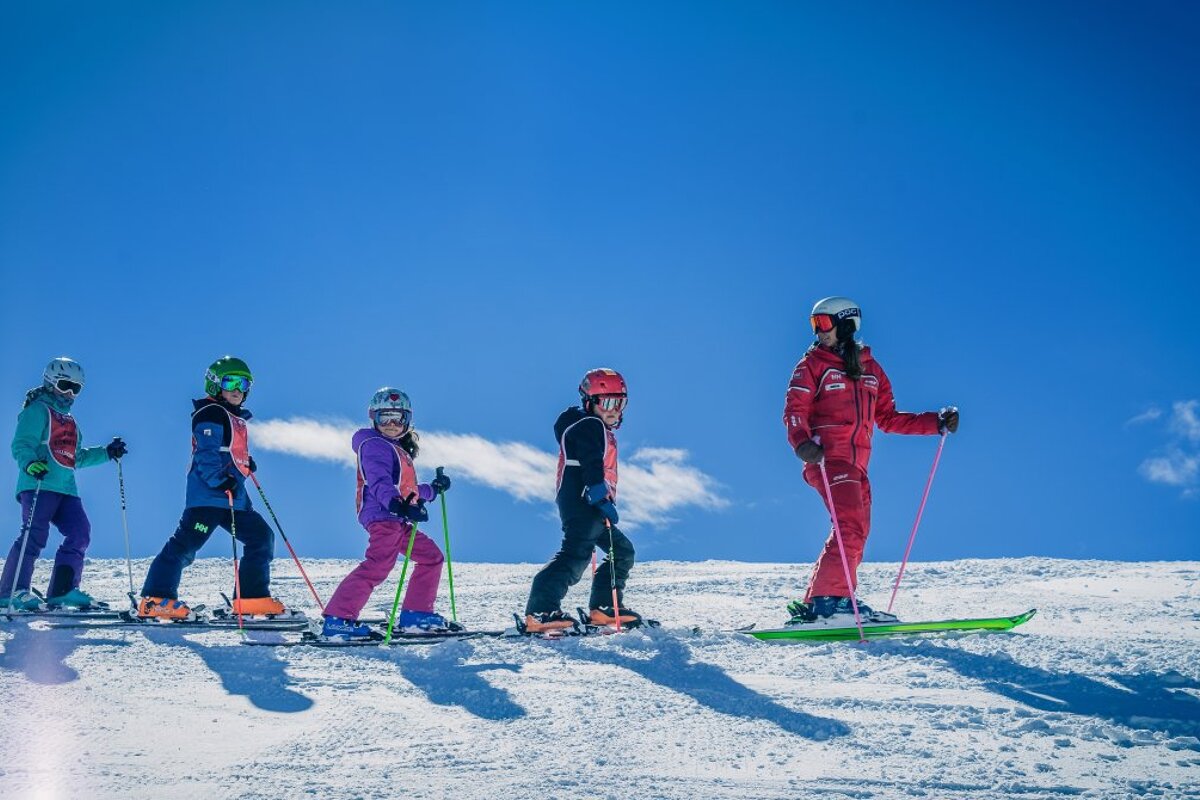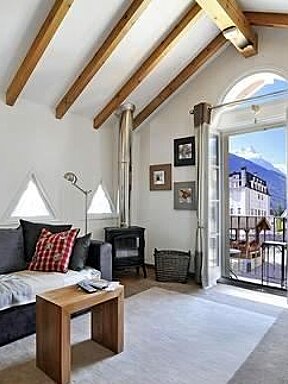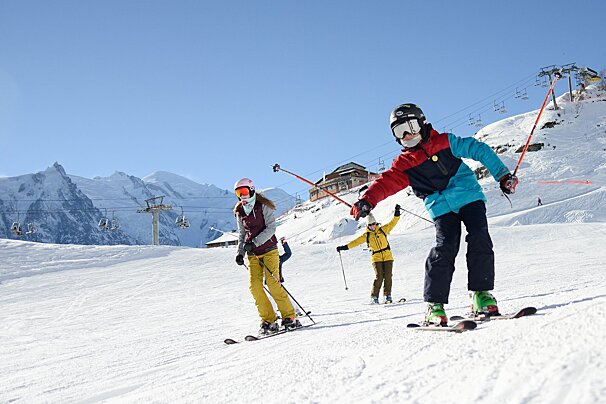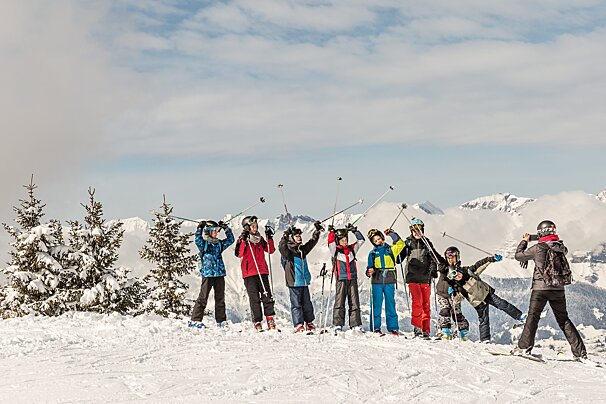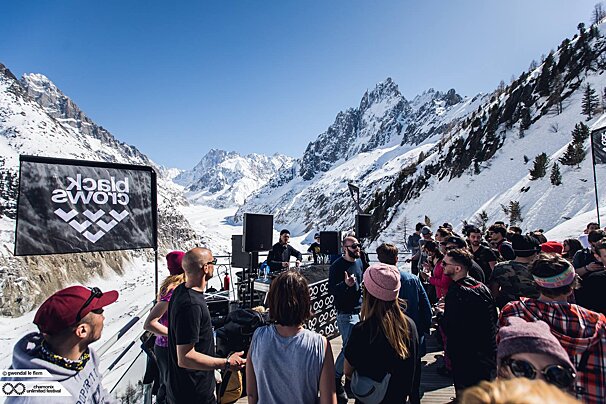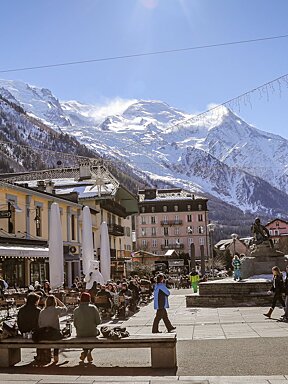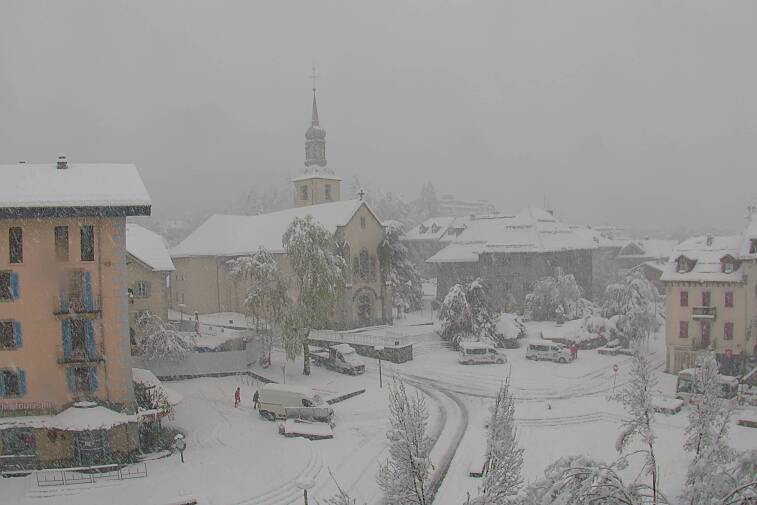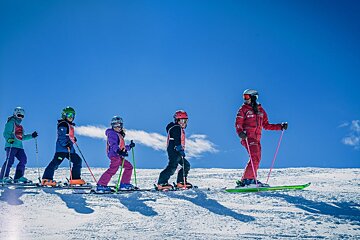
© ESF Vallorcine
Ski lessons in Chamonix
How to book ski and snowboard lessons in Chamonix
Whether you’re a complete beginner or a seasoned pro skier, ski lessons are an essential part of any winter holiday.
It doesn't matter if it’s your first time or you’d like to venture off-piste and get the hang of riding powder, you’ll learn more quickly and safely with an instructor avoiding any bad habits. Plus ski and snowboard lessons are a lot of fun for all ages.
There are plenty of options to consider when choosing a school, from the type of lesson to understanding the different ski and snowboard levels, and even knowing what to bring to your first lesson. We’re here to help you make the best choices so that you can fully enjoy your holiday in our beautiful valley.

Things to consider before booking a lesson in Chamonix
Once you've decided if you're skiing or snowboarding, these are the main things we think you should consider before you book a lesson:
Group or private lessons?
You can join a group lesson with other skiers or snowboarders of a similar level, or have one-on-one instruction.
What level are you?
This will help the school place you in the most suitable group. If you're not sure, it will quickly become clear to the instructor, who usually perform a level assessment before your first lesson to make sure you’re getting the best instruction possible.
Where is the ski school meeting point?
The easier it is to get from your accommodation to your lesson, the better for everyone. This is especially important if you have kids with you and therefore lots to carry. There is a great network of free shuttle buses that’ll bring you near to your ski school's designated meeting point.
Are beginner ski passes available?
Beginners benefit from special discounted passes that access the ski area’s nursery slopes. Check with your school, you may not need a pass for your first couple of lessons.

Adult ski lessons in Chamonix
Ski schools usually offer adult lessons to anyone aged 12 to 13 years old and over, although some have specific programmes for teens.
You're never too old…
As long as you're reasonably in shape, there's no age limit. Many instructors have training in teaching older beginners, and checking with your doctor before you hit the slopes is also recommended. They'll make sure you're fit to ski or snowboard.
…to ski or snowboard
When comparing the two, skiing is usually easier to learn but harder to master, whilst snowboarding is harder to learn but easier to master - sort of.
With skiing you can expect that within your first few days you'll be putting in turns down easy slopes and having fun.
Snowboarding offers a completely different learning experience. Expect to fall a lot more (we suggest you invest in some knee pads, wrist guards and impact shorts). But as progress is much quicker, after a few lessons you should reach that lightbulb moment when it will just click.
As for which one is more dangerous, they're more or less on a level playing field. The injuries tend to be different, the knees suffer more from skiing whilst snowboarders usually sustain more damage to the upper body.
You'll very likely need at least a week of lessons to get the hang of your new sport, but the more lessons you take the faster you'll progress.
If possible, have a couple of lessons on a nearby dry or snow slope centre at home to learn the very basics before hitting the pistes for real.

Child ski lessons in Chamonix
The best way for your kids to learn how to ski or snowboard is to go to have lessons. They’ll also get to enjoy fun activities and meet other children their age. Some schools even provide lunch or childcare (or both), either for half-day or full day lessons, so you'll get more time for yourself on the slopes.
Skiing
The youngest age ski schools usually accept children is two and a half to three years old. They have designed the lessons to combine short bursts of mostly shuffling around on skis, combined with activities in a snow garden or 'Jardin de Neige' (a fun area for kids to learn in a safe environment).
This type of programme is usually offered for children aged four and under. The recommended age for children to join regular group ski lessons is usually four to five years old, where lessons comprise of two to three hours, morning or afternoon.
Some ski schools offer group lessons for older children and teens, with the possibility of learning freeride, freestyle and off-piste technique. Ask if they offer anything like this, otherwise, consider putting your child into an adult lesson.
Snowboarding
Usually lessons for children are from around ages seven to 10 plus. It’s been argued that snowboarding requires more muscle development in the legs, plus more coordination, balance and stamina than skiing. Things are changing and there are schools offering lessons for children as young as four. Enquire when booking.
Our local team's advice:
- put snacks in their pockets for when they get a break
- especially for young children, put a note in their pocket with your name and telephone number in case the school needs to contact you
- tape their name and your number onto their helmet
- be on time (or better still, early) for both drop off and pick-up. Ski instructors are not babysitters and will not wait with your child if you aren't there

Group vs private ski lessons in Chamonix
When booking your lesson in Chamonix, you’ll find that there are two options: group or private. These depend on whether you book the whole lesson for yourself and your group or you share it with other people.
Group lessons
These usually run for five or six days (either Sunday to Friday or Monday to Friday) for two to four hours in the morning or afternoon. Groups tend to be comprised of six to eight people, up to a maximum of 10.
Pros:
- cost - less expensive than private lessons
- sociable - meet new people whose ski level is similar to yours
Cons:
- you'll be sharing your instructor with others, so you won't get their undivided attention
- progression is usually slower than in private lessons
- dates and times are fixed
Group lessons are highly recommended for beginner and intermediate skiers who want to learn the basics at an affordable price, and it's usually more fun. Popular for children, they are grouped with others their age allowing for a fun, friendly environment.
Our local team's advice:
- book peak weeks well in advance (Christmas, New Year, Easter and the February school holidays)
Private lessons
No one is above a private lesson, even those of us that have been hitting the slopes for over 20 years! The schools usually offer private lessons for a minimum of two hours and a maximum of a full day, and you can book them for as many days as you want.
Pros:
- accommodates small groups, ranging from one to six people whose level is more or less the same
- personalised attention
- improve at your own pace and focus on the skills you want to master or those you struggle with
- the instructor will tailor the lesson to your interests and needs, such as off-piste riding or learning to ski-tour or split-board
- more flexible in time, duration and location than group lessons
Cons:
- more expensive than group lessons
- not to be confused with a guide, they are strictly there to focus on your technique, not give you a tour of the resort
Our local team's advice:
- be ready to be taken outside your comfort zone - they will find flaws in your technique you didn't even know existed
- listen to their advice and tips - you'll get a handful of exercises to work on for the rest of your stay
For up to date prices, availability and to book your lesson, take a look at our selection of the best ski schools.

Ski levels in Chamonix
Every ski school has its own system to assess the skier’s and snowboarder’s level, in order to place the student in the best-suited group lesson, or to decide which areas to focus on during a private lesson. The instructor will perform a level assessment before starting the lesson to ensure that you’ve been assigned to the right group.
Which snowboard or ski level are you?
There are four basic levels that can be applied to both adults and kids in both sports, usually divided into more specific sub-categories. Different schools will give them different names but these are the basics:
| Level | Slopes | Skills |
| Beginner | First-timer | You’ve never skied or snowboarded before or have spent less than a week on dry slopes |
| Green | Skiers: you can do the snowplough Boarders: you can side slip and do falling leaf | |
| Green → Blue | Skiers: you can do snowplough turns Boarders: you can do basic C-shaped turns | |
| Intermediate | Blue | Skiers: you can link turns at moderate speed on green and blue runs and are starting to master parallel turns Boarders: you can do S-shaped turns |
| Blue → Red | You’re confident going down blue runs | |
| Advanced | Red | You ski red runs in control and make very good turns |
| Red → Black | You can ski black runs and moguls in control, you're starting to venture off-piste and ski all kinds of snow, from bumps to powder | |
| Expert | All Mountain | You can ski on and off-piste confidently and in control, regardless of the snow quality, and can hit almost any feature in the snow park |
| Freeride/Park/Race | You want to improve certain specific skills or want to start racing or instructor training |

Ski school meeting points and beginner areas in Chamonix
It's worth knowing the meeting points before you book your lessons to ensure its proximity to your accommodation.
Where are the ski school meeting points in Chamonix?
Most schools meet at the bottom of the lifts in the Chamonix Valley's different ski areas: Brévent, Flégère, Grands Montets, Le Tour, Vallorcine and Les Houches.
Beginner lessons often meet at one of the six nursery ski areas in the valley:
- Le Savoy and Les Planards in Chamonix Town
- La Poya in Vallorcine
- La Vormaine in Le Tour
- Les Chosalets in Grands Montets
- Le Tourchet in Les Houches
Private instructors may also be able to meet you at a location of your choice, you just need to ask if they offer this service.
What's Chamonix like for beginners?
Don't be fooled by Chamonix's reputation as an extreme resort, the huge mountain playground that is the Chamonix Valley is also a great place to learn to ski. It boasts six dedicated beginner areas at the bottom of the valley, as well as a few nursery slopes higher up on the mountain with gentle green and blue runs.
Chamonix Town:
Chamonix centre has two low-altitude beginner ski areas that are easily accessible on foot or by bus: Le Savoy and Les Planards.
- Les Planards is the biggest beginner area in the centre of Chamonix, located just across the road from the Montenvers-Mer de Glace train station. There are two drag lifts here, as well as a chairlift that you can ride once you're confident skiing the green pistes, as it takes you to a longer but still gentle blue run.
- Le Savoy is situated at the bottom of the Planpraz gondola in Brévent, behind La Folie Douce Hotel. There are two drag lifts and a magic carpet here, giving access to a handful of nice and wide pistes with a very gentle gradient. Once you've learned the basics, you can take the Planpraz gondola up to the Brévent ski area where there are a couple of easy green and blue runs to try out.
Les Houches:
Hailed as the most family-friendly resort in the valley, Les Houches boasts three beginner areas: Le Tourchet, plus two higher up the mountain, one in Prarion and one in Bellevue.
- At the bottom of the valley, there's Le Tourchet. Two drag lifts serve a really nice and wide slope, perfect for gaining confidence. This piste is also open at night on Thursdays during the peak season.
- The beginner area located at the arrival of the Prarion gondola features a magic carpet and a short and easy chairlift serving a green piste that's ideal to practise riding a chairlift for the first time.
- At the top of the Bellevue cable car, there's a drag lift with a green piste.
Grands Montets:
Famous for its freeride lines and steep faces, you may be surprised to learn that Grands Montets also has a great nursery ski area
- Les Chosalets is at the bottom of the lifts. Serviced by two drag lifts, it has two quite different runs: one is very short and flat while the other one is longer and wider, which makes it a good slope for progressing on.
- There's also a beginner's area at Grand Montet's mid-station, near the top of the Plan Joran cable car. Here, two drag lifts give access to two gentle green runs and a longer blue piste.
Le Tour/Balme:
The largest beginner ski area in the Chamonix Valley is located at the bottom of the Le Tour lifts.
- La Vormaine has four drag lifts of varying lengths and a magic carpet. This very wide and flat area features several green runs as well as a long blue piste and a small snowpark.
Vallorcine:
At the top end of the Chamonix Valley, on the way to Vallorcine and the Swiss border is the La Poya nursery slope, located in the small hamlet of Le Buet.
- Two small drag lifts and a rope tow are available for beginner skiers and snowboarders here, while there's also a children's play area.

Beginner lift passes in Chamonix
Before purchasing your ski pass, talk to your ski school or private instructor, they'll be able to recommend the most suitable lift pass for your needs depending on where they're going to take you, and your ski and snowboard level. Many ski schools also sell discounted ski passes to those booking a lesson with them, ask when reserving your course.
Are beginner ski passes available in Chamonix?
Yes, there are beginner ski passes available for each of the six nursery slopes in the Chamonix Valley:
- Le Savoy
- Les Planards
- Le Tourchet
- Les Chosalets
- La Vormaine
- La Poya
These are offered at a fraction of the price of a full lift pass and are only available at the ski pass offices at the bottom of each of the nursery slopes.
To reach the beginner areas located higher up on the mountains, you'll need to purchase a full Chamonix Le Pass, a Les Houches pass or a Mont-Blanc Unlimited pass.

What to wear and what to bring
If you're a first timer, you may feel a bit lost as to what you need to bring to your first lesson. Here's a list of what we believe are the most important things to bring to your first lesson:
Ski wear:
- A warm and waterproof jacket and trousers or salopettes and gloves or mittens. Borrow or hire them if you've never skied before. You may decide that this new sport isn't for you, and ski gear isn't cheap. Some ski rental shops in resort may offer clothing for rent.
Layers:
- Weather on the mountain can change pretty quickly, so you’re much better off wearing layers of thinner items as opposed to a big, bulky jumper. Try thermal tops and leggings plus fleeces. A neck warmer is also a must, especially if the weather turns.
Socks:
- Bring a variety of socks ranging in thickness. It may sound weird but, in our experience, rental boots can be quite painful with the wrong socks.
Goggles or sunglasses:
- The sun shines brighter on the slopes as it reflects on the white snow, so you want to make sure your eyes are protected. We personally prefer goggles as they also protect your eyes from the wind and snow, and you can change their lenses to low-visibility ones when the weather is bad.
Ski or snowboard gear:
- Bring your ski or snowboard boots, snowboard or skis and poles with you to your first lesson. Again, if you're a beginner or have kids in lessons we recommend you hire them at a rental shop. If you're in the market for a new set up read our helpful guides on skis and snowboards.
Helmet:
- Wearing a helmet in lessons is strongly recommended, even if it’s not a legal requirement. You can never be too careful! Most hire shops rent helmets as standard so you won't need to purchase one unless you want your own. Take a look at our helpful guide.
Sunscreen:
- Sun reflects off the snow, therefore its intensity is magnified and even when it’s cloudy the sun can (and will) get you. Don't forget to keep topping up with a good layer of SPF50+ sunscreen on your face, and a lip balm with an SPF50+ is also a must.
Take a look at our helpful guide on winter clothing for more info on all of the above.

What else is there to learn in Chamonix?
Ski schools in Chamonix offer a wide range of lessons, catering to all levels of skiers and snowboarders from complete beginners to expert off-piste riders, as well as all ages and budgets.
There are a host of lesser-known lessons on offer here, all of which are available in English.
Off-piste skiing and snowboarding
If you’re looking for off-piste technique and ski guiding, there are a number of local ski and snowboard instructors and mountain guides who know the area like the back of their hand and will be able to take you exploring.
When booking an off-piste lesson with an instructor, you’ll hone your skills and master riding all kinds of snow, from powder to crust and corn. You’ll also learn how to be safe in the backcountry with avalanche and glacier rescue training.
Clinics and courses
There are a number of specialist courses and clinics offered by the schools focused on specific skills, which can help build your technical ability and improve your overall skiing or snowboarding. There may be clinics specifically designed for tackling bumps and moguls, powder snow, steep skiing, freestyle jumps and tricks in the snow park, ski racing, boardercross, glacier rescue, avalanche training or courses meant only for women.
Handiskiing
Handiski makes skiing much more accessible for disabled skiers and less-able bodied people. Highly qualified instructors will accompany you around the pistes and onto the ski lifts, making sure you are safe and have a great experience. There is usually a range of equipment available, including sit-skis, uniskis and dual skis.
Cross-country skiing and biathlon
Cross-country or Nordic skiing will have you pushing yourself across flat(ish) snowfields on narrow skis, either using the classic or the skating style. Biathlon, on the other hand, is a fun combination of cross-country skiing and shooting created as part of Norway's military training in the 19th century.
Ski touring and splitboarding
When ski touring or splitboarding, you'll get the chance to climb up the slopes on your touring skis or splitboard aided by the skins attached to the base of your planks, being able to explore outside the ski area bounds. For expert skiers and snowboarders only.
Telemarking
Named after the region of Telemark in Norway where this technique originated in the 19th century, telemarking is a ski style that combines aspects of Alpine and Nordic skiing. Your heel will remain unattached to your bindings so you'll have to slide down by bending your knees... we promise it's a great workout.

Skiing and snowboarding tips
The best way to learn to ski and snowboard, and the only way to do it safely, is to book a group lesson or a private instructor.
For those keen to practise a bit on their own after their ski school course, we've teamed up with some of the resort's top ski and snowboard instructors who have compiled a list of the key skiing tips and snowboarding tips to improve your riding.
